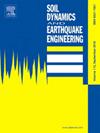Correlation between the excess cavity gas pressure and the dynamic response of a slope cavity under strong earthquake conditions
IF 4.2
2区 工程技术
Q1 ENGINEERING, GEOLOGICAL
引用次数: 0
Abstract
There are often some cavity structures in engineering slopes, such as early structural fracture cavities, dissolution fracture cavities, existing seismic fracture cavities, abandoned mines, etc. The excess pore gas pressure generated in engineering slopes with cavities under the action of sudden seismic loads, as well as the damage characteristics and mechanisms of the slope, the action laws of excess pore gas pressure, the mechanism of gas-rock interactions, and the triggering mechanism of seismic landslides, are all important research topics. This study, on the one hand, provides a valuable supplement to the theoretical foundation for understanding the deformation and failure mechanisms of slopes under seismic action; on the other hand, it provides a scientific basis for seismic slope stability evaluation and disaster prevention. In this study, a large-scale shaking table physical model test was designed for the slope with cavity. Under certain similar conditions, by inputting different seismic waves, the correlation between the excess cavity gas pressure and the dynamic response of the slope under strong earthquake conditions was systematically studied. The study found that: (1) Under the condition of low-intensity earthquake, there is almost no excess cavity gas pressure in the slope cavity, and the dynamic response of the slope has the same characteristics as that of the ordinary slope. (2) Under the condition of strong earthquake, the slope cavity will produce instantaneous excess cavity gas pressure, and the peak of air pressure will change with the change of cavity elevation, excitation intensity and excitation frequency. (3) Under the condition of strong earthquake, the peak value of acceleration response in the slope with cavity often appears after the peak pressure, which proves that the excess cavity gas pressure has a significant effect on the dynamic response of the slope.
求助全文
约1分钟内获得全文
求助全文
来源期刊

Soil Dynamics and Earthquake Engineering
工程技术-地球科学综合
CiteScore
7.50
自引率
15.00%
发文量
446
审稿时长
8 months
期刊介绍:
The journal aims to encourage and enhance the role of mechanics and other disciplines as they relate to earthquake engineering by providing opportunities for the publication of the work of applied mathematicians, engineers and other applied scientists involved in solving problems closely related to the field of earthquake engineering and geotechnical earthquake engineering.
Emphasis is placed on new concepts and techniques, but case histories will also be published if they enhance the presentation and understanding of new technical concepts.
 求助内容:
求助内容: 应助结果提醒方式:
应助结果提醒方式:


